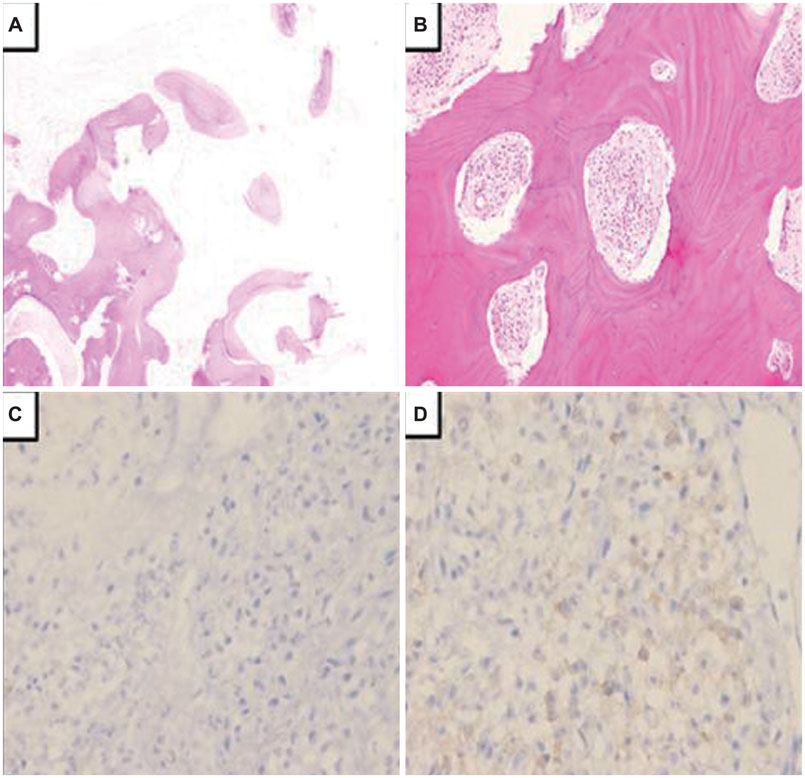Brain Tumor Res Treat.
2015 Oct;3(2):122-126. 10.14791/btrt.2015.3.2.122.
Multimodal Treatment of Skull Base Inflammatory Pseudotumor: Case Report
- Affiliations
-
- 1Department of Neurosurgery, Dongtan Sacred Heart Hospital, College of Medicine, Hallym University, Hwaseong, Korea. kosaken@lycos.co.kr
- KMID: 2114659
- DOI: http://doi.org/10.14791/btrt.2015.3.2.122
Abstract
- lnflammatory pseudotumor (IPT) is a rare, non-neoplastic inflammatory process. It is most commonly occurs in the orbit, but extension into brain parenchyma is uncommon. In a confirmed case of IPT, most cases show good improvement with steroid theraphy. A 50-year-old man with progressive left-eye visual disturbance and mass lesion was admitted in a hospital. A left orbital mass biopsy revealed what was highly suspected as an inflammatory pseudotumor. Steroid pulse therapy with dexamethasone, radiation therapy, and chemotherapy with amphotericin B were performed, but they were not effective in improving the condition of the patient. Revision open surgery was then performed. A follow-up brain enhancement computerized tomography showed an enlarged mass volume and hydrocephalus with periventricular enhancement. As an additional procedure, ventriculoperitoneal shunt and tuberculosis medication were administered. About 2 weeks later, clinical symptoms and radiologic findings improved. We present a case of intra-cranial IPT and discuss further treatment methods.
MeSH Terms
Figure
Reference
-
1. Gandhi RH, Li L, Qian J, Kuo YH. Intraventricular inflammatory pseudotumor: report of two cases and review of the literature. Neuropathology. 2011; 31:446–454.
Article2. Saifudheen K, Jose J, Gafoor VA. Inflammatory pseudotumor of the head presenting with hemiparesis and aphasia. Case Rep Neurol Med. 2011; 2011:176546.
Article3. Ohue S, Kohno S, Matsui S, Kumon Y, Ohnishi T. Inflammatory pseudotumor in the lateral ventricle. Case report. Neurol Med Chir (Tokyo). 2012; 52:599–602.4. Lin YJ, Yang TM, Lin JW, Song MZ, Lee TC. Posterior fossa intracranial inflammatory pseudotumor: a case report and literature review. Surg Neurol. 2009; 72:712–716. discussion 716
Article5. Lee EJ, Jung SL, Kim BS, et al. MR imaging of orbital inflammatory pseudotumors with extraorbital extension. Korean J Radiol. 2005; 6:82–88.
Article6. Coffin CM, Humphrey PA, Dehner LP. Extrapulmonary inflammatory myofibroblastic tumor: a clinical and pathological survey. Semin Diagn Pathol. 1998; 15:85–101.7. Jung TY, Jung S, Lee MC, et al. Hemorrhagic intracranial inflammatory pseudotumor originating from the trigeminal nerve: a case report. J Neurooncol. 2006; 76:139–142.
Article8. Park SB, Lee JH, Weon YC. Imaging findings of head and neck inflammatory pseudotumor. AJR Am J Roentgenol. 2009; 193:1180–1186.
Article9. Coffin CM, Dehner LP. Fibroblastic-myofibroblastic tumors in children and adolescents: a clinicopathologic study of 108 examples in 103 patients. Pediatr Pathol. 1991; 11:569–588.
Article10. Fukunaga A, Yoshida K, Otani M, et al. Plasma cell granuloma extending from the extracranial to the intracranial space associated with Epstein-Barr virus infection. Neurol Med Chir (Tokyo). 1998; 38:292–296.
Article
- Full Text Links
- Actions
-
Cited
- CITED
-
- Close
- Share
- Similar articles
-
- A Case of Invasive Fungal Sinusitis Accompanied with Inflammatory Pseudotumor in Skull Base
- A Case of Inflammatory Pseudotumor Involving Skull Base and Cervical Spine
- A Case of Inflammatory Pseudotumor Cerebri and Nasal Septum
- Iatrogenic Skull Base Defect Accompanied by Brain Injury After Endoscopic Sinus Surgery: A Report of Two Cases
- Fibrosing Inflammatory Pseudotumors of the Skull Base




